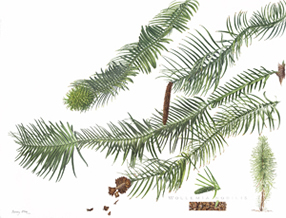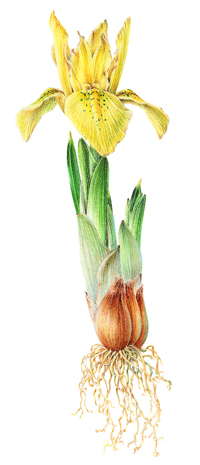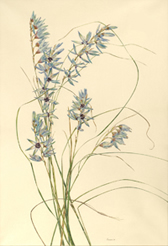USA: Botanical art showcases rare plants at NYBG
21.04.10
The New York Botanical Garden will exhibit Losing Paradise? Endangered Plants Here and Around the World in the Arthur and Janet Ross Gallery from Thursday, May 6, through Sunday, July 25, 2010.
 The traveling exhibition and accompanying catalogue feature botanical artwork of at-risk plants from all six habitable continents. The culmination of a three-year project undertaken by artists from the United States and around the world, Losing Paradise? is curated by the American Society of Botanical Artists (ASBA) and developed in collaboration with the Smithsonian’s National Museum of Natural History.
The traveling exhibition and accompanying catalogue feature botanical artwork of at-risk plants from all six habitable continents. The culmination of a three-year project undertaken by artists from the United States and around the world, Losing Paradise? is curated by the American Society of Botanical Artists (ASBA) and developed in collaboration with the Smithsonian’s National Museum of Natural History.
Wollemi Pine by Beverly Allen, Australia
“Featured as part of the Garden’s Education programs, Losing Paradise? provides viewers with a glimpse of some of the world’s most endangered specimens and will help inform the public about plants that are disappearing every day,” said Jeff Downing, Vice President for Education at The New York Botanical Garden. “The exhibition will showcase the beauty of these endangered treasures, as well as the fine craft of botanical art.”
 According to recent studies on plant endangerment, it is estimated that 20% of the world’s flora is threatened with extinction. Scientists racing to gather information on known plants and to document the estimated 50,000 plant species yet to be scientifically described, benefit from the work of botanical artists who capture the breadth of plant diversity and make audiences aware of precious dwindling species. Losing Paradise? showcases the artwork of botanical artists from the United States, Australia, Brazil, Israel, South Korea, South Africa, and the United Kingdom - some of whom are the world’s most renowned botanical artists, while others are relative newcomers to the field. All of the artists are members of the ASBA. The exhibition catalogue includes the story behind each plant’s endangerment and the method the artist took to locate and capture the specimen artistically.
According to recent studies on plant endangerment, it is estimated that 20% of the world’s flora is threatened with extinction. Scientists racing to gather information on known plants and to document the estimated 50,000 plant species yet to be scientifically described, benefit from the work of botanical artists who capture the breadth of plant diversity and make audiences aware of precious dwindling species. Losing Paradise? showcases the artwork of botanical artists from the United States, Australia, Brazil, Israel, South Korea, South Africa, and the United Kingdom - some of whom are the world’s most renowned botanical artists, while others are relative newcomers to the field. All of the artists are members of the ASBA. The exhibition catalogue includes the story behind each plant’s endangerment and the method the artist took to locate and capture the specimen artistically.
Iris winogradowii by John Pastoriza-Pinol, Australia
About half of the plants represented in the exhibition are native to North America, and the remaining plants are from other locations around the world. Fascinating plant stories include that of the Wollemi pine, thought to be extinct for 2 million years but found in 1994 in a remote Australian canyon, and Phragmipedium kovachii, a stunning violet slipper orchid discovered in 2002 in the Peruvian rain forest.
American rarities include the mid-western lake-side daisy, with only two natural colonies remaining in the United States, the Everglades “ghost orchid,” a rare white poppy from Utah’s Mojave Desert, and California’s coastal Santa Cruz cypress, all listed as Federally Endangered or Threatened.
 “Recognising that a significant percentage of the world’s plant species will face a serious threat of extinction in the next century, The New York Botanical Garden and other research gardens around the world are partnering to generate the information needed to guide an effective conservation strategy, to protect plants where they grow naturally, to cultivate them in gardens, and to restore them to their natural habitats,” said Dr. James S. Miller, Vice President for Science at the Botanical Garden, who provided a forward to the Losing Paradise? exhibition catalogue.
“Recognising that a significant percentage of the world’s plant species will face a serious threat of extinction in the next century, The New York Botanical Garden and other research gardens around the world are partnering to generate the information needed to guide an effective conservation strategy, to protect plants where they grow naturally, to cultivate them in gardens, and to restore them to their natural habitats,” said Dr. James S. Miller, Vice President for Science at the Botanical Garden, who provided a forward to the Losing Paradise? exhibition catalogue.
Ixia viridiflora by Jean Emmons, USA
The exhibition may be viewed from 10 a.m. to 6 p.m. when the Garden is open to the public and is included in the price of admission. The Losing Paradise? catalogue is currently available for purchase at Shop in the Garden. The artwork featured in Losing Paradise? will be available for purchase during the exhibition. Proceeds from the sale of the artwork will benefit the Garden.
Related links:
UK: Rare plant returns to old school haunt
19.04.10
 Late last year Plant Talk reported on an ambitious plan to create a third population of one of Britain's rarest plants on the site of a historic population; Charterhouse School in Surrey.
Late last year Plant Talk reported on an ambitious plan to create a third population of one of Britain's rarest plants on the site of a historic population; Charterhouse School in Surrey.
19.04.10
 As spring begins to take a firm hold on the British countryside the timing is perfect for the launch of Plantlife's Wildflowers Count - the successor to Common Plants Survey.
As spring begins to take a firm hold on the British countryside the timing is perfect for the launch of Plantlife's Wildflowers Count - the successor to Common Plants Survey.